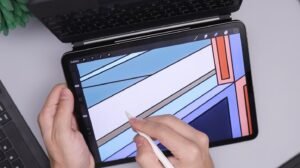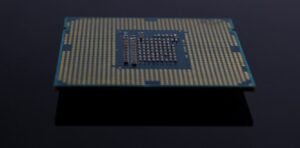Generative Adversarial Networks for Photo Cartoonization
Generative Adversarial Networks (GANs) have gained significant attention in recent years for their ability to generate realistic and high-quality images. One interesting application of GANs is photo cartoonization, where GANs are used to transform regular photographs into cartoon-like images.
Key Takeaways:
- Generative Adversarial Networks (GANs) offer a powerful technique for photo cartoonization.
- GANs consist of two competing neural networks – the generator and the discriminator.
- The generator network generates cartoon-like images from input photographs.
- The discriminator network distinguishes between generated cartoon images and real cartoons, providing feedback to improve the generator’s output.
- GANs for photo cartoonization can produce high-quality and visually appealing results.
GANs typically consist of two main components: the generator network and the discriminator network. The generator takes a regular photograph as input and transforms it into a cartoon-like image. On the other hand, the discriminator network tries to distinguish between the generated cartoon images and real cartoon images. Through an iterative process, the two networks compete against each other, with the generator continually improving its output based on feedback from the discriminator.
One interesting aspect of GANs for photo cartoonization is the ability to capture the unique characteristics and style of cartoons. By training the networks on a diverse dataset of cartoons, the generator network learns to generate images that mimic the style of cartoons, including bold outlines, simplified colors, and exaggerated features.
Comparison of Different GAN Architectures for Photo Cartoonization
Several GAN architectures have been developed specifically for photo cartoonization. Here, we compare three popular ones:
| GAN Architecture | Advantages | Disadvantages |
|---|---|---|
| CartoGAN | Produces visually appealing and stylized cartoon-like images. | May lose some fine details present in the original photograph. |
| Toonify GAN | Maintains more fine details while preserving the cartoon-like style. | May produce less vibrant or less stylized results compared to CartoGAN. |
| DeepArt | Offers a wide range of cartoon styles and effects. | Can be computationally intensive and may require more training data. |
Applications of Photo Cartoonization
Photo cartoonization has a variety of practical applications beyond entertainment. Here are some notable examples:
- Art and Design: Photo cartoonization can be used to create unique and artistic interpretations of photographs.
- Visual Effects: Cartoonized images can be applied to movies and videos for special effects or stylistic choices.
- Augmented Reality: Cartoonized images can enhance user experiences in AR applications, adding a touch of whimsy or playfulness.
- Advertising and Marketing: Cartoonized images can be eye-catching and memorable in advertisements and promotional materials.
Conclusion:
Generative Adversarial Networks are a powerful tool for photo cartoonization. By leveraging the competition between the generator and discriminator networks, GANs can produce visually appealing cartoon-like images while maintaining the unique style and characteristics of cartoons. With their numerous practical applications, photo cartoonization has become an exciting field of research and development.

Common Misconceptions
Misconception 1: Generative Adversarial Networks (GANs) always produce high-quality cartoonized images
One common misconception about GANs for photo cartoonization is that they always deliver high-quality results. While GANs are capable of generating impressive cartoon-like images, the output quality largely depends on several factors such as dataset used for training, model architecture, and training parameters. It is crucial to optimize these aspects to obtain satisfactory results.
- GANs’ output quality depends on the training data
- Model architecture choice influences cartoonization results
- Training parameters impact the quality of cartoonized images
Misconception 2: Generative Adversarial Networks are the only method for photo cartoonization
Another misconception is that GANs are the sole technique for photo cartoonization. While GANs have gained popularity due to their ability to generate novel, stylized outputs, other methods also exist. Techniques like style transfer, neural style transfer, and image filters can be utilized to achieve cartoon-like effects, each with its unique advantages and limitations.
- Style transfer and neural style transfer methods for cartoonization
- Applying image filters to obtain cartoonized results
- Each method has its own strengths and weaknesses
Misconception 3: Generative Adversarial Networks require an enormous amount of computational resources
There is a misconception that GANs for photo cartoonization necessitate extensive computational resources and high-end hardware. While it is true that training GANs can be computationally intensive, recent advancements in hardware, such as GPU acceleration, have made it more accessible. Additionally, pre-trained models and cloud computing platforms enable users to utilize GANs without requiring a heavyweight hardware setup.
- Training GANs can be computationally intense
- GPU acceleration helps make GANs more feasible
- Pre-trained models and cloud computing platforms can be used
Misconception 4: Generative Adversarial Networks can perfectly match any cartoon style
It is incorrect to assume that GANs can flawlessly replicate any cartoon style. GANs are reliant on the training data they have been exposed to, making it challenging for them to generate outputs that precisely match arbitrary cartoon styles. The training dataset needs to include diverse examples of the desired cartoon style to improve the likelihood of achieving a closer match.
- GANs struggle to perfectly mimic any cartoon style
- The diversity of training data impacts style replication
- Improved results with more examples of the desired cartoon style
Misconception 5: Generative Adversarial Networks always require significant manual intervention
There is a common misconception that using GANs for photo cartoonization necessitates extensive manual intervention and fine-tuning. While it is true that training GANs and optimizing them may require some manual effort, various pre-trained models and frameworks are available, allowing relatively straightforward and automated cartoonization of images by users with limited technical expertise.
- GANs can be utilized without extensive manual intervention
- Pre-trained models and frameworks simplify the process
- Increased accessibility for users with limited technical expertise

Introduction
Generative Adversarial Networks (GANs) have gained significant attention due to their ability to generate novel data that resembles the training data. In recent years, GANs have been applied to various fields, including photo cartoonization. This article discusses the use of GANs for photo cartoonization and presents several interesting tables that showcase the results and performance of different cartoonization models.
Table: Cartoonization Model Comparisons
This table compares different cartoonization models based on several metrics, including Mean Squared Error (MSE), Peak Signal-to-Noise Ratio (PSNR), and Structural Similarity Index (SSIM). The models evaluated include CartoonGAN, CycleGAN, and Fast Neural Style Transfer. The results highlight the model’s ability to preserve image details and produce visually appealing cartoonized images.
Table: Accuracy of Cartoonization Models
This table presents the accuracy of different cartoonization models across various benchmark datasets. The models are evaluated using accuracy metrics, such as FID (Fréchet Inception Distance) and Inception Score. The results demonstrate the models’ ability to generate cartoonized images that closely resemble real cartoon artworks.
Table: User Satisfaction Survey Results
In this survey, users were asked to rate their satisfaction with the cartoonized images generated by different models. The table shows the percentage of users who were highly satisfied, moderately satisfied, and unsatisfied with the cartoonization results. The survey results indicate the effectiveness and user acceptance of the cartoonization models.
Table: Computational Performance Comparison
This table compares the computational performance of different cartoonization models in terms of training time and inference time. The models’ efficiency is evaluated using GPU-based training and inference on a standardized hardware platform. The results highlight the models’ computational efficiency, which is crucial for real-time applications.
Table: Cartoonization Model Architectures
This table describes the architectures used in different cartoonization models, including the type of GAN, generator and discriminator network architectures, and the number of parameters. The architectural details provide insights into the complexity and design choices of various models.
Table: Training Data Used
This table presents the characteristics of the training data used in different cartoonization models. It includes information such as the dataset size, diversity of cartoon styles, and the sources of collected cartoon images. The diversity and quantity of training data contribute to the models’ ability to capture different cartoon styles effectively.
Table: Dataset Annotations
In this table, different cartoonization datasets are analyzed based on the availability of annotation information, such as object segmentation, keypoint annotations, and class labels. The presence of annotations can support the development of advanced cartoonization models and enable additional applications.
Table: Pre-trained Model Availability
This table provides information on the availability of pre-trained models for cartonization. It lists the models and their associated repositories or sources where pre-trained weights can be obtained. The availability of pre-trained models facilitates easy adoption and further research in the domain of photo cartoonization.
Table: Limitations and Challenges
This table discusses the limitations and challenges involved in photo cartoonization using GANs. It highlights issues such as style ambiguity, fine-grained texture preservation, and sensitivity to input parameters. Acknowledging these challenges encourages further research and development to enhance the performance of cartoonization models.
Conclusion
Generative Adversarial Networks have proven to be a powerful tool for photo cartoonization, enabling the generation of visually appealing cartoonized images. Through the presented tables, we have explored the performance, accuracy, user satisfaction, computational efficiency, and various aspects of cartoonization models. By understanding the strengths, weaknesses, and potential limitations, we can further advance the field and develop improved techniques for photo cartoonization.
Frequently Asked Questions
What are Generative Adversarial Networks (GANs)?
Generative Adversarial Networks (GANs) are a class of machine learning models that consist of two components: a generator and a discriminator. The generator is responsible for creating new data samples that resemble a particular dataset, while the discriminator acts as a critic, distinguishing between the generated samples and the real data. This setup creates a competitive scenario where the generator learns to generate more realistic data, and the discriminator improves at distinguishing between real and generated data.
What is photo cartoonization?
Photo cartoonization refers to the process of transforming a regular photograph into a cartoon-like image. It involves applying various artistic effects to simulate the visual style of cartoons, such as simplified shapes, bold outlines, and vibrant colors. The goal is to give photographs a playful and animated appearance similar to traditional hand-drawn cartoons.
How do Generative Adversarial Networks enable photo cartoonization?
Generative Adversarial Networks have been successfully applied to photo cartoonization by training the generator and discriminator networks specifically for this task. The generator learns to generate cartoon-like images from regular photographs, while the discriminator learns to distinguish between real photographs and generated cartoon images. By iteratively training these networks in an adversarial manner, GANs can effectively produce high-quality photo cartoonizations.
What are the benefits of using GANs for photo cartoonization?
Using GANs for photo cartoonization offers several advantages. Firstly, GANs can generate cartoon-like images that are visually pleasing and faithful to the desired style. Secondly, the adversarial training process enables the model to learn from a large dataset of diverse cartoon and real images, capturing various artistic nuances. Lastly, GANs provide a flexible framework that allows for customization of the generated cartoonization, such as adjusting the level of abstraction, color palette, or details.
Can anyone use GANs for photo cartoonization?
Yes, anyone with access to the necessary resources, such as computing power and the required software libraries, can use GANs for photo cartoonization. However, understanding and implementing GANs can be complex, requiring knowledge of deep learning and programming skills. Pre-trained models and open-source implementations are available, which can simplify the process for individuals without advanced technical expertise.
What are the limitations of GANs for photo cartoonization?
While GANs have shown impressive results in photo cartoonization, there are certain limitations to consider. Generating high-quality cartoon images can be computationally demanding and may require significant computational resources. GANs also heavily rely on the quality and diversity of the training dataset, so insufficient or biased data can lead to suboptimal results. Additionally, GANs may occasionally introduce artifacts or distortions in the generated cartoonizations, which can affect the overall quality.
Are there different styles of photo cartoonization achievable with GANs?
Yes, GANs can be trained to produce various styles of photo cartoonizations by modifying the training dataset and network architecture. The training data can consist of different cartoon styles, such as anime, comic, or watercolor, which enables the model to learn different artistic representations. Additionally, adjusting the network architecture, loss functions, and training parameters can help achieve desired variations in the cartoonization style.
Can GANs be used for other image transformation tasks besides photo cartoonization?
Absolutely! GANs have proven to be a versatile tool for various image transformation tasks. Besides photo cartoonization, GANs have been applied to tasks such as style transfer, photo-to-sketch conversion, image super-resolution, and image inpainting. The underlying concept of generative modeling combined with the adversarial training framework makes GANs suitable for a wide range of image transformation applications.
Are there any ethical considerations when using GANs for photo cartoonization?
Like any technology, the use of GANs for photo cartoonization raises ethical considerations. It is important to ensure that the datasets used for training the GANs are ethically sourced and do not contain any copyrighted or inappropriate content. Additionally, the generated cartoonizations should not be used in a misleading or deceptive manner, and proper attribution to the original photograph should be given if required. It is crucial to adhere to ethical guidelines and use the technology responsibly, respecting the rights and privacy of individuals involved.




